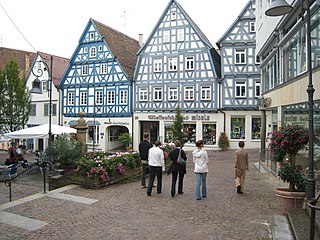
Waiblingen is a town in the southwest of Germany, located in the center of the densely populated Stuttgart region, directly neighboring Stuttgart. It is the capital and largest city of the Rems-Murr district. As of 31 December 2018, Waiblingen had 55,449 inhabitants.
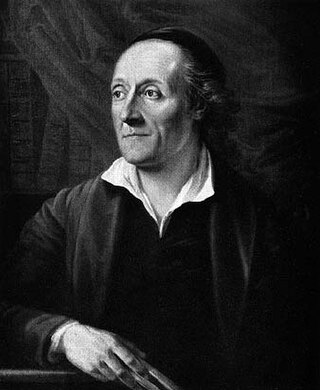
Johann KasparLavater was a Swiss poet, writer, philosopher, physiognomist and theologian.
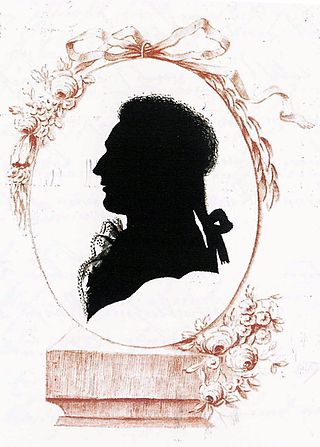
A silhouette is the image of a person, animal, object or scene represented as a solid shape of a single colour, usually black, with its edges matching the outline of the subject. The interior of a silhouette is featureless, and the silhouette is usually presented on a light background, usually white, or none at all. The silhouette differs from an outline, which depicts the edge of an object in a linear form, while a silhouette appears as a solid shape. Silhouette images may be created in any visual artistic medium, but were first used to describe pieces of cut paper, which were then stuck to a backing in a contrasting colour, and often framed.

Charlotte Albertine Ernestine von Stein, born von Schardt; 25 December 1742, Eisenach – 6 January 1827, Weimar, was a lady-in-waiting at the court in Weimar and a close friend to both Friedrich Schiller and Johann Wolfgang von Goethe, whose work and life were strongly influenced by her.

Johann Friedrich, Freiherr Cotta von Cottendorf was a German publisher, industrial pioneer and politician.

Therese Huber was a German author. She was one of the so-called Universitätsmamsellen, a group of five academically active women during the mid-18th and early 19th centuries. The group consisted of daughters of academics at Göttingen University; Huber was noteworthy among them, alongside Meta Forkel-Liebeskind, Caroline Schelling, Philippine Engelhard, and Dorothea Schlözer.

Weimar Classicism was a German literary and cultural movement, whose practitioners established a new humanism from the synthesis of ideas from Romanticism, Classicism, and the Age of Enlightenment. It was named after the city of Weimar, Germany, because the leading authors of Weimar Classicism lived there.

Papercutting or paper cutting is the art of paper designs. Art has evolved all over the world to adapt to different cultural styles. One traditional distinction most styles share is that the designs are cut from a single sheet of paper as opposed to multiple adjoining sheets as in collage.
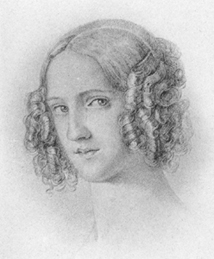
Josephine Caroline Lang was a German composer. Josephine Lang was the daughter of Theobald Lang, a violinist, and Regina Hitzelberger, opera singer. Her mother taught young Josephine how to play piano, and from age five it became apparent that Josephine was possessed with great potential as a composer. As early as age eleven Josephine started giving piano lessons herself. Through her godfather, Joseph Stieler, Josephine was exposed to some of the greatest artists of her time. Both Felix Mendelssohn and Ferdinand Hiller went to great lengths to ensure that Lang learned the proper theory for song-writing, and used their connections to publish Lang's music. Even Robert Schumann published a song of Josephine's in Neue Zeitschrift für Musik in 1838.

Charlotte Sophie Luise Wilhelmine von Ahlefeld was a German novelist.
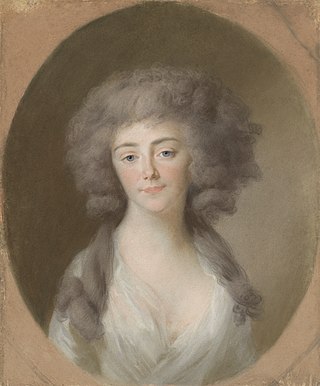
Louise Isabelle Alexandrine Augusta, Countess of Sayn-Hachenburg, Burgravine of Kirchberg, full German name: Luise Isabelle Alexandrine Auguste, Gräfin zu Sayn-Hachenburg, Burggräfin von Kirchberg was the Princess consort of Nassau-Weilburg through her marriage to Frederick William, Prince of Nassau-Weilburg.
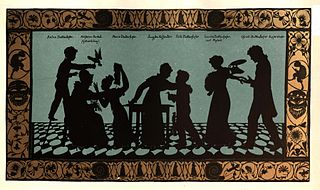
Christian Friedrich Traugott Duttenhofer was a German engraver.

Jewish paper cutting is a traditional form of Jewish folk art made by cutting figures and sentences in paper or parchment. It is connected with various customs and ceremonies, and associated with holidays and family life. Paper cuts often decorated ketubbot, Mizrahs, and ornaments for festive occasions. Paper cutting was practiced by Jewish communities in both Eastern Europe and North Africa and the Middle East for centuries and has seen a revival in modern times in Israel and elsewhere.
Wang Zigan was a modern papercutting artist, master of arts and crafts, and famous Shanghai-style papercutter. His most important representative works are "The crowing of the cock", "Chicken eats centipede", etc. Some of his published works include "Selected papercutting works of Wang Zigan", "History of Shanghai papercutting" and "The creation of papercutting".
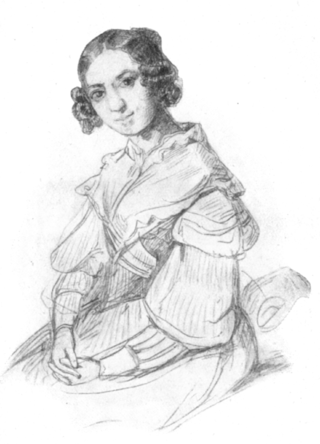
Luise Adelaide Lavinia Schopenhauer, known as Adele Schopenhauer, was a German author. She was the sister of the philosopher Arthur Schopenhauer and daughter of author Johanna Schopenhauer. Henriette Sommer and Adrian van der Venne were pseudonyms used by her.

Gottlob Friedrich Steinkopf was a German landscape painter in the Classical style.
Duttenhofer is a surname. Notable people with the surname include:

The Morgenblatt für gebildete Stände was a German cultural and literary journal that existed from 1807 to 1865. It appeared daily until 1851, when it was changed to a weekly journal. The Morgenblatt was published by Cotta in Tübingen and later in Stuttgart, and was the most important German literary and cultural journal of its time.

Clara von Greyerz was a German papercutting artist. She was born in Mainz, the daughter of world traveller Georg Forster and his wife Therese. Her father became a revolutionary in the Republic of Mainz from 1792 until his death in 1794, while her mother lived in the Neuchâtel area with her lover and eventual husband Ludwig Ferdinand Huber. The family moved to Tübingen, Stuttgart and Ulm, where her stepfather died in December 1804, when she was already engaged to the forester Gottlieb von Greyerz. They married in 1805, living in Stoffenried, Günzburg, Augsburg and Bayreuth, and had ten children between 1806 and 1832. In Augsburg, von Greyerz became acquainted with Hortense de Beauharnais, and her children played with Hortense's son, the future Napoleon III of France. Von Greyerz was known for her papercuts, some of which she swapped with fellow artist Luise Duttenhofer. In 1836, she visited Hortense at Arenenberg and published a report of her experiences there.

Karen Bit Vejle is a Danish papercut artist. She lived in Trondheim, Norway from 1984 to 2014, and currently lives in Denmark.






















